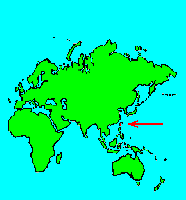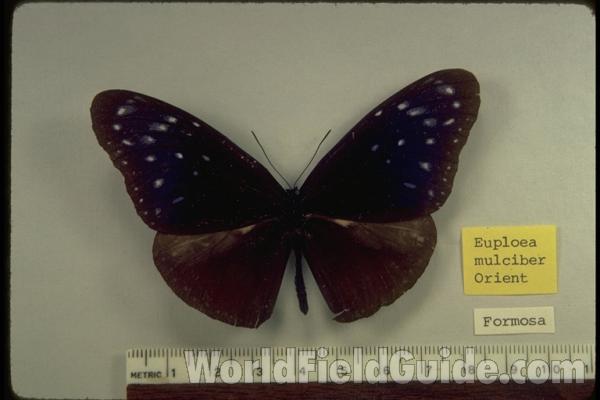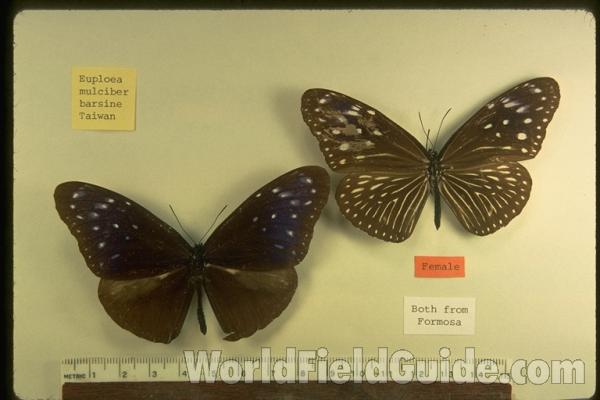SPECIES INFO
Euploea mulciber is found from India into Burma, Thailand, China, and south into Malaysia, Sumatra, Java, and east into the Philippines. The subspecies barsine is found in Taiwan. As can be seen from the images, the species exhibits sexual dimorphism.Euploea genus is widespread in both the Oriental and Indo-Australian region. There are also representatives on islands near Africa. There are several species that vary considerably from location to location and care must be taken in identification. This situation is complex as the different species frequently mimic each other at any given location.
This list shows the tentative divisions of this genus by Paul Smart. Ranges and comments have been added. Following are the species in his fourth group:
Euploea mulciber - India to Burma , Java, Taiwan, Philippines, Widespread
Euploea gelderi - this Flores form perhaps is a subspecies of mulciber
Euploea euctemon (=configurata) - Celebes (Sulawesi)
Euploea semperi - Mindoro form perhaps a subspecies of mulciber
The Euploea genus is very complex and there are as many opinions as there are scientists. This presentation is to be viewed as but a tentative survey.
Milkweed butterflies (Danaid family) are found throughout the world. Although the United States has only a few species (including the common and well-known Monarch), countries like Malaysia and Taiwan have over a dozen species each in this family.
Most of the species in the Danaus and Idea genera can be identified by picture matching. However, the Euploea genus has some complex identification problems enhanced by geographical dimorphism. Species in Malaysia, for example, tend to look alike, and the same species when found in Borneo will look totally different and yet similar to each other. For further research one can refer to plate 23 of "The Butterflies of the Malay Peninsula" by Corbet and Pendlebury which states: "Indeed, in such cases it is easier to ascertain the country of origin of a specimen than to determine its specific identity,"
The task of identifying a group of Euploea butterflies from a specific place can be helped by the following tips. The trailing edge of the forewing in many Euploea species is rounded in the male and straight in the female. This will easily and quickly permit one to sex and match many of the specimens as the dot patterns are usually similar across the sexes. The male sex brand near the trailing edge of the wing on the dorsal side in male specimens is also useful for identification purposes. The double sex brand is unique to the Euploea sylvester/dufresne complex. A single large sex brand might indicate a specimen in the E. algea group.
Butterflies and Moths (Order Lepidoptera) are a group of insects with four large wings. They go through various life cycles including eggs, caterpillar (larvae), pupae, and adult. Most butterflies and moths feed as adults, but primarily do most of their growing in the larval or caterpillar stage. Also, most species are restricted to feeding as caterpillars upon a unique set of plants. In this pairing of insects to plants, there arises a unique plant population control system. When one plant species becomes too common, specific pests to that species also become more common and thus prevent the further spreading of that particular plant species.
Although most people think of the Lepidoptera as two different groups: butterflies and moths, technically, the concept is not valid.
Some families, such as Silk Moths (Saturnidae) and Hawk Moths (Sphingidae), are clearly moths. Other families, such as Swallowtail Butterflies (Papilionidae), are clearly butterflies, However, several families exhibit characteristics that appear to be neither moths nor butterflies. For example: the Castnia Moths of South America are frequently placed in the Skipper Family (Hesperidae). The Sunset Moths (Uranidae) have long narrow antennae and fly during the day.
The Saturnidae (Silk Moths) and Papilionidae (Swallowtails) are two Lepidoptera families that have been very carefully researched as to species and subspecies. The current thinking is that if the male genitalia are alike, then the two specimens belong to the same species. As an amateur, your editor disagrees with this premise. If the genitalia are different, then no doubt two species are involved. However, if the genitalia are alike, it only proves that the genitalia are alike.
Consider Papilio multicaudata which is found in southern Canada at higher altitudes. Papilio multicaudata is found south through the Rocky Mountains as far south as Mexico City, and recently as far south as Guatemala. With different food plants, different soil types, different climates, and different seasonal patterns, it is hard to believe that this complex is all one species.
Consider capturing 100 living individuals at any life stage in Guatemala and then carrying them north to southern Canada. Would these individuals survive through several generations. If they would not survive, then this author would conclude that two different species are involved!
In the Saturnidae consider Eacles imperialis subspecies pini. This life form feeds on pines. Is not this sufficient to justify a full species status?
Note: Numerous museums and biologists have loaned specimens to be photographed for this project.
Insects (Class Insecta) are the most successful animals on Earth if success is measured by the number of species or the total number of living organisms. This class contains more than a million species, of which North America has approximately 100,000. (Recent estimates place the number of worldwide species at four to six million.)
Insects have an exoskeleton. The body is divided into three parts. The foremost part, the head, usually bears two antennae. The middle part, the thorax, has six legs and usually four wings. The last part, the abdomen, is used for breathing and reproduction.
Although different taxonomists divide the insects differently, about thirty-five different orders are included in most of the systems.
The following abbreviated list identifies some common orders of the many different orders of insects discussed herein:
Odonata: - Dragon and Damsel Flies
Orthoptera: - Grasshoppers and Mantids
Homoptera: - Cicadas and Misc. Hoppers
Diptera: - Flies and Mosquitoes
Hymenoptera: - Ants, Wasps, and Bees
Lepidoptera: - Butterflies and Moths
Coleoptera: - Beetles
Jointed Legged Animals (Phylum Arthropoda) make up the largest phylum. There are probably more than one million different species of arthropods known to science. It is also the most successful animal phylum in terms of the total number of living organisms.
Butterflies, beetles, grasshoppers, various insects, spiders, and crabs are well-known arthropods.
The phylum is usually broken into the following five main classes:
Arachnida: - Spiders and Scorpions
Crustacea: - Crabs and Crayfish
Chilopoda: - Centipedes
Diplopoda: - Millipedes
Insecta: - Insects
There are several other "rare" classes in the arthropods that should be mentioned. A more formal list is as follows:
Sub Phylum Chelicerata
C. Arachnida: - Spiders and scorpions
C. Pycnogonida: - Sea spiders (500 species)
C. Merostomata: - Mostly fossil species
Sub Phylum Mandibulata
C. Crustacea: - Crabs and crayfish
Myriapod Group
C. Chilopoda: - Centipedes
C. Diplopoda: - Millipedes
C. Pauropoda: - Tiny millipede-like
C. Symphyla: - Garden centipedes
Insect Group
C. Insecta: - Insects
The above list does not include some extinct classes of Arthropods such as the Trilobites.
Animal Kingdom contains numerous organisms that feed on other animals or plants. Included in the animal kingdom are the lower marine invertebrates such as sponges and corals, the jointed legged animals such as insects and spiders, and the backboned animals such as fish, amphibians, reptiles, birds, and mammals.



